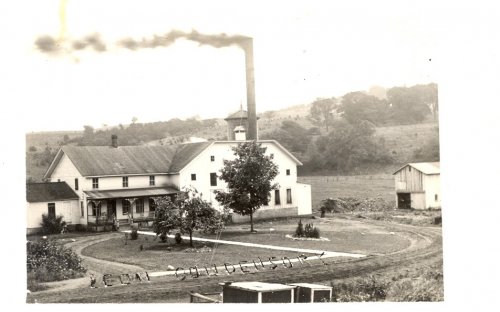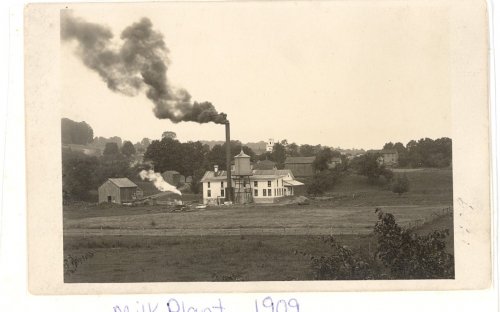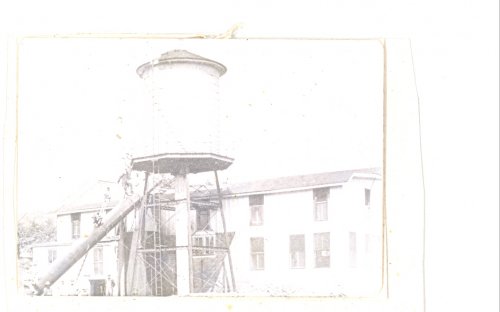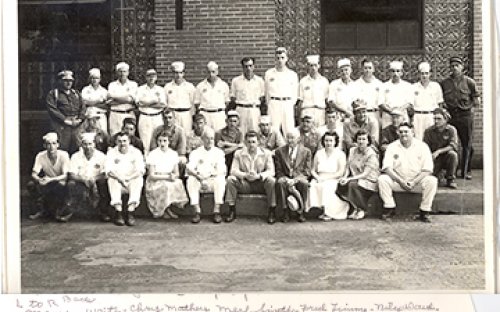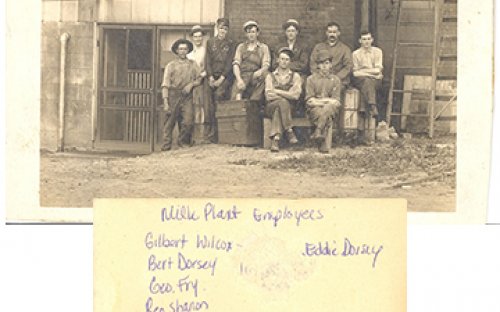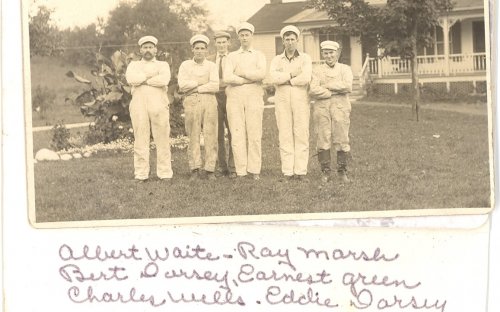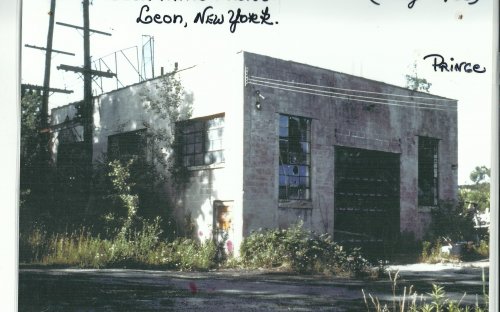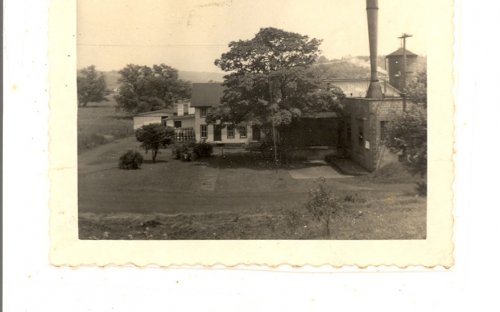In 1886, Jenks and Ross built a creamery or cheese factory at East Leon. At one time, it was a large plant that received milk from more than 1,000 cows. The same year, Hunt and Caneen erected a two-story building, 30x120, on East Road at Leon Center. It was known as the Jenks and Ross No. 2 factory.
In 1869, Wells and Thompson built a factory on Lot 32 at North Leon. They had 20 producers, and William Thompson was the cheesemaker. Another factory was erected on East Road out of the Center, built by G.S. Mosher. Next year, Albert Ackler became the owner and handled milk from 200 cows. In 1875, farmers of the Kysor Hill section erected on Lot 49 by Jenks and Ross, their No. 5. It was later taken over by William Thompson. William Smith, a New York City wholesaler of milk and cheese, changed the plant into a milk-sugar manufacturing operation. He located here on account of the large supply of spring water availalbe for condensing an abundance of whey from the cheese factories in Cattaraugus and Chautauqua Counties and as far away as it could be economically drawn by horse teams. It contained large steam boilers, vacuum condensing pans, filter presses, large vats into which condensed whey was run and allowed to stand until the milk sugar separated from the liquid. This sugar was washed and dried, then elevated to grinders, after which it was packaged and shipped.
After this plant was closed about 1895, Welly Meyers built a cheese factory on the road in the bend of Mud Creek on Flat Iron. While this was in operation, a nearby farmer lost a horse that was found drowned in the whey tank. After this plant closed, another was opened in one of the buildings at the old sugar-making factory. This later factory was purchased by Joseph Dorsey, who owned the Leon Center cheese factory in which he separated sweet cream for shipment to Buffalo. He installed in this factory a separator for producing cream for the sweet-cream trade and ice-cream manufacture. In 1897, he moved his family from Randolph to North Leon where he built a cheese factory on land now owned by Ralph Earl on Lot 40, at the intersection of Rt. 62 and the County Rd from East Leon. He purchased the Peace Vale factory and one at Cherry Creek. In the fall of 1907, he sold all his factories to the Hoefler Ice Cream Corporation of Buffalo. The new owners closed all the plants except the Leon Center factory which they enlarged and converted to a condensed milk plant. It is now a large operation owned by the General Ice Cream Corporation, a subsidiary of National Dairy, Inc.
Albert Ackler built a cheese factory on Lot 22, Wells Hill, on the farm of Harrison Franklin near the three corners where the Monkey Run road comes from Alder Bottom. He built another factory on Rt. 62, in North Leon, near the itersection with Kysor road. These operated only a few years.
In Peace Vale, there were three cheese factories built and operated at different times. The first was on the north side of the Leon-New Albion road at the intersection of the Gudway road. The second was on the same side of the road but west and in the bend of the creek; the building is now the home of the Leon Iron and Metal Works. A third was on the southeast corner of Dugway road. It was owned by the Hoefler Ice Cream Corporaion which, after clsoing the plant, deeded it to the Peace Vale school district. The district moved the school building down South Hill so it would be on the flats and not up the Dugway hill. After the district was centralized in the Pine Valley system, the building was sold.
A cheese factory was operated near the bridge in East Leon for a short time. After it was closed, a factory was built on the east of the road about three-fourths of a mile sourth of the four corners at East Leon. When its supply of milk was diverted to condenseries, the plant was closed and the building was moved in sections to Peace Vale to become No. 3 at that location.
About 1916, a large number of Leon farmers joined the Dairymen's League Co-Operative Association and refused to sell milk to the local condensery. They purchased the large building that had been used as a wagon shop by Herman Kiearstead, at the bridge just east of the four corners at Leon. It was equipped as a cheese factory, but it operated only a short time and is now a garage owned by Floyd Rowland.
Leon, no doubt, was one of the first towns in the county to make any progress in the dairy industry. At first, butter and cheese were made on the farm by the family. One family, the Kelloggs, who operated a large farm on Kellogg Hill in Lot 29, made late history. Producing cheese of good quality, they sold from the farm to customers or to stores in nearby towns, and continued until about 1915.
Also, they were pioneers in raising black-and-white Holstein cattle. At first, this breed was thought to produce milk of low butterfat content, but about1890 Professor S.M Babcock invented a milk test known as the Babcock test which is still in use with very little change. Soon the cheese factories adopted this test for paying for milk. Milk-condensing plants paid only by test, but farmers were slow to change from native cattle to better-bred stock. Now, almost all farmers in the town have black-and-white herds. Before the use of this test, cheese and butter factories had considerable trouble with some farmers who skimmed the cream off or added water. Use of this test did away with the practices.
The creamery at Leon Center was built about 1878 by Mahlon L. Crowley at a cost of $4,000 and had forty producers when opened. It was erected at a particular location on account of the large spring of fresh, cold water available. The lot contained three acres. This building was 28x60 feet, two stories high, with a wing used as a dwelling. This wing was 26x28 feet with a basement that was used as storage for butter. The building has had many additions since.
Erected before the time of cream separators, the milk upon arrival at the plant was run into what were called "shotgun cans". They were pails about 28 inches high and 8 inches in diameter, from heavy tin, with a bail at the top and heavy wire around the bottom for a base. They were filled with fresh milk and set in pools of cold, fresh water to allow the cream to rise to the top of the pails. The pools covered about two-thirds of the floor area of the building and were approximately 10 feet wide by 12 long. With water nearly to the top of the pails, the milk "set" in about 24 hours, when the pails were removed and taken by men to a large vat. This was not a very efficient method of removing cream from milk.
The skimmed milk was made into skim-milk cheese or taken back by the farmers as feed for calves and pigs. It was claimed that they could raise some very good stock from returned skilm milk and buttermilk. About 1890, manufacture of butter in this plant was discontinued and only cheese was made.
The cream remained in the vat about twenty-four hours to ripen, or become sour; then it was transferred by pails into the churn which had a capacity of 390 gallons. After the butter was churned and washed in cold water, it was removed and put on tables about four feet square where salt was worked into the butterby hand with a wooden ladle. Then it was packed into tubs or firkins and stored in the cool cellar until shipped.
In January, 1903, Joseph Dorsey purchased the factory from John McAdam and moved into the factory house in March of that year. He had come from the Town of Villenova, Chautauqua County, where he owned the Beardsley factory and others.
During the next three years, he enlarged the work space in the plant by laying floors over all but one of the open water pools, installing a large 50-horsepower boiler and engine, cream separators, milk pumps, mechanical cheese-vat stirrers and powered cheese-curd grinders.
A market was developed in Buffalo for sweet cream for use as fluid cream or in the manufacture of ice cream. Most of the skim milk was returned to the farmer for feed; however, at times some was made into cheese that was shipped to New York City, Buffalo and Pittsburgh. For the first time, as far as known, manufactured milk paid the farmers more than $1 per 100 pounds of milk.
The outcome of this operation was that in November, 1907, this plant and those at North Leon, Peace Vale, Flat Iron and one at Cherry Creek, all owned by Joe Dorsey, were sold to the Hoefler Ice Cream Corporation and is now a subsidiary of General Ice Cream Corporation, one of the largest dairy organizations in the world.
Purchase of these properties was the beginning of one of the largest milk-manufacturing plants in Cattaraugus County. It makes Leon an outstanding town of the County and one noted for its large processing plant for milk.
The Hoefler Company at first doubled the size of the building by the addition of a new two-story section and erected a steel tower with a 16-foot water-storage tank on top. They installed a new 150-horsepower, coal-fired Erie City boiler with a 75-foot smokestack, a new steam engine and larger DeLaval cream separators operated by steam turbines.
Pasteurization of cream and milk was just beginning to be put into operation, so they installed a Reid vertical continuous pasteurizer. This was a copper tank about 20 inches in diameter and 24 high and surrounded by a steamheated, hotwater jacket. The milk entered at the bottom, was stirred around and around by a powered paddle, and came out at the top with a temperature of about 165 degrees F.
Among other equipment placed in the plant was a Wagner ammonia compressor, a cork-insulated coldroom for storage, a milk-condensing department was added, with a five-foot vacuum pan together with cooling tanks and hot wells.
At the time the Hoefler company purchased the plant, it still was in the horse-and-buggy days. The only transportation for raw milk from the farm to the plant and of products from the plant to the Erie railroad at Conewango was by horse teams and wagons or sleighs. Soft coal was used for fuel and it came by the Erie. Kerosene oil was used for lighting; later, acetylene gas was installed as an illuminant. The generator of this lighting plant blew up at one time but the creamery did not catch fire.
All the highways were just plain dirt, dust, mud or snow and ice. The plant maintained a stable of six or eight horses and hired farmers to help with the transportation.
At this time, few farmers had milk houses. In cold weather, milk in 30-gallon cans were delivered by farmers to the plant every other day. The man weighing, sampling and receiving the milk could easily tell which farmers held their milk overnight in the kitchen and had wheat pancakes for breakfast. This flavor together with that of onions and boiled cabbage did not improve ice cream made from such milk. While butter or cheese was made at this early time, there was very little sanitary inspection either on the farm or at the plant.
However, the State had inspectors that called at creameries and cheese factories once or twice a year and took lactometer readings of the farmer's milk to determine if any water had been added or cream removed. In order to prove a case against a producer, the inspectors would go to the farm and hide some place to watch all night to see when any water was added or cream removed. In one case the cheese maker found a fish in the milk strainer on the vat. The inspector saw the farmer dip water from a stream he had to ford on his way from farm to cheese factory. He dipped the fish with the water and gave himself away.
With no inspections, many things did happen. A foreign-born farmer delivered his milk in a 30-gallon can in which the cheese maker saw a drowned cat and told the farmer he could not use the milk with a cat in it. The farmer reached into the can, took the cat out, threw it under his wagon seat and said, "No cat in milk, can you take it?"
In cheese and butter factories, the farmers owned the cheese or butter and pooled receipts; the plant manager received pay for processing the milk. With the coming of condenseries that purchased milk at a stated price per 100 pounds', based on the butter-fat content by the Babcock test, frequent inspections, milk houses with cold water for cooling, 40-quart cans in the place of 30 or 40 gallon cans, and daily deliveries required. Now there are plants that use no milk cans but use tanks at the farm for cooling with bulk tanks for delivery direct to the plant.
During the former ownership of the plant, several different dairy products were made. The idea was to find a profitable way to dispose of the surplus skim milk so it would not have to be returned to the farm or dumped on the ground. They made casein from skim milk and from the resulting whey, lactose or milk sugar was produced.
Skim milk was condensed and in most cases heat treated and called superheated condensed. This was used by break bakers and ice-cream makers. At times, sugar was added to the condensed so that when ready for market it contained about 40 percent sugar. It was stored or sold in either 40-quart milk cans or new parafin-lined barrels which held about 600 punds of condensed milk.
From time to time, addition to the buildings have been made. New makes and models of up-to-date machines, more ice machines, two new 250 horsepower boilers have been added, and powder rolls ahve been replaced by spray powder equipment. At one time, the first two 150-horsepower boilers had gas burners, the fuel coming from the local field. The three old-style vacuum pans were replaced with large sized Blaw-Knox condensing pans. An up-to-date receiving room was built which receives 15 cans per minute.
In addition, surplus milk is received by tank trucks holding from 8,000 to 12,000 quarts each. This milk comes from Buffalo, Rochester and other points. It is made into milk powder and is shipped in bags or fiber barrels. At the present time, milk, cream, and condensed milk are sent in large, stainless tank trucks to Buffalo, New York City, Boston, and other points. Powdered milk is shipped by truck transport and by Erie Railroad. Surplus pasteurized cream is churned into butter that is packaged in cardboard boxes. The present-day churn will finish at each churning around 2,000 pounds of butter.
The General Ice Cream Corporation, a subsidiary of National Dairy, which still owns the plant, has sold or disposed of all the outside skimming stations and owns only the John Greeley farm of 153 acres, using the land for waste disposal and the barn for storage. A large water reservoir is for use by the plant and its sprinkler system. Water from this storage may be used by the local fire company to combat fires near the Center. This plant furnishes employment for about 50 persons. Managers of the plant since 1907 have been B.J. Dorsey, William Rogers, Allan Kidder and Victor Hierl.
Source: History of the Town of Leon and Historian Pat Bromley

